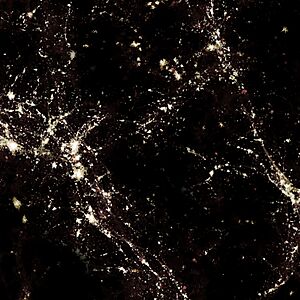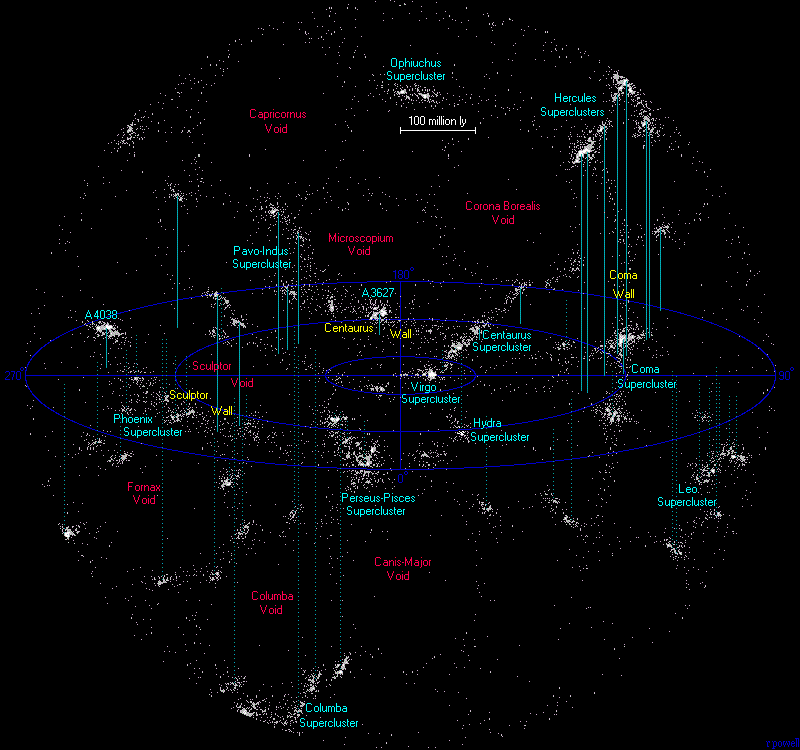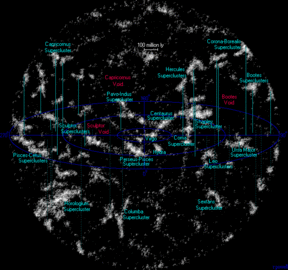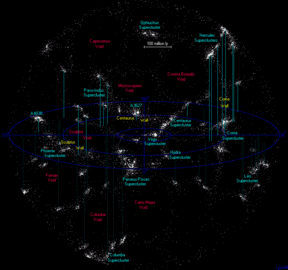Galaxy filament facts for kids
In space science, galaxy filaments are the biggest known structures in the universe. Think of them as giant, thread-like formations made of many superclusters of galaxies all held together by gravity. These huge threads can be incredibly long, stretching for hundreds of millions of light-years! They form the edges around huge empty spaces in the universe called voids. Together, galaxy filaments create a vast, web-like pattern across the cosmos, often called the cosmic web. This web defines how the entire observable universe is structured.
Contents
How We Found These Giant Structures
Scientists started finding structures even bigger than superclusters in the late 1980s.
Early Discoveries (1980s-2000s)
- In 1987, an astronomer named R. Brent Tully from the University of Hawaii found something he called the Pisces–Cetus Supercluster Complex. This was one of the first hints of these massive threads.
- Then, in 1989, the CfA2 Great Wall was discovered. This was a huge, flat sheet of galaxies.
- Later, in 2003, the Sloan Great Wall was found. It was even bigger than the CfA2 Great Wall.
Recent Discoveries (2010s)
- In January 2013, a team of researchers led by Roger Clowes announced they had found a large quasar group called the Huge-LQG. This group was much bigger than any galaxy filament found before it.
- In November 2013, astronomers used powerful gamma-ray bursts to help them find the Hercules–Corona Borealis Great Wall. This is an incredibly huge filament, stretching more than 10 billion light-years across! It's currently the largest known structure in the universe.
Types of Galaxy Filaments
Galaxy filaments come in different shapes. Some are more like long threads, while others are flatter, like walls.
Filaments (Thread-like Structures)
These filaments are like long, thin strings of galaxies. They have a similar thickness all the way around.
- The Coma Filament is one example. The Coma Supercluster is located inside it. This filament is also part of the larger CfA2 Great Wall.
- The Perseus–Pegasus Filament is connected to the Pisces–Cetus Supercluster. The Perseus–Pisces Supercluster is part of this filament.
- The Ursa Major Filament is connected to a region called the CfA Homunculus.
- The Lynx–Ursa Major Filament (or LUM Filament) was discovered in 1999. It is connected to, but separate from, the Lynx–Ursa Major Supercluster.
- In 2004, scientists found a very long filament that was about 110 million parsecs long. It was as long as the "Great Wall" and was the biggest structure found beyond a certain distance until 2008.
- Scientists have also suggested a short filament near our own Milky Way galaxy and the Local Group of galaxies.
Galaxy Walls (Flat Structures)
Galaxy walls are a type of filament that are much wider than they are thick, like a giant sheet.
- The CfA2 Great Wall was the first super-large structure found in the universe. It was discovered in 1989. It is about 750 million light-years long, 250 million light-years wide, and 20 million light-years thick. The Coma Supercluster is a major part of this wall.
- The Sloan Great Wall was found in 2003. It was the largest known galaxy filament until the Hercules–Corona Borealis Great Wall was discovered ten years later. It is about 433 million parsecs long.
- The Sculptor Wall is a large wall of galaxies. It is "parallel" to the Fornax Wall and "perpendicular" to the Grus Wall.
- The Grus Wall is another wall that is "perpendicular" to the Fornax and Sculptor Walls.
- The Fornax Wall includes the Fornax Cluster of galaxies. It is "parallel" to the Sculptor Wall and "perpendicular" to the Grus Wall.
- The Hercules–Corona Borealis Great Wall was discovered in 2013. It is the largest known structure in the universe, stretching about 3 billion parsecs long!
Map of Nearest Galaxy Walls
Large Quasar Groups (LQGs)
Large quasar groups (LQGs) are some of the biggest structures known. Scientists think they might be early versions of superclusters or galaxy filaments.
- The Clowes–Campusano LQG was discovered in 1991. It was the largest known structure in the universe from 1991 until 2011. Its longest side is about 630 million parsecs.
- U1.11 was found in 2011. It was the largest known structure for a few months, with a longest side of 780 million parsecs.
- The Huge-LQG was discovered in 2012. It was the largest known structure until the Hercules–Corona Borealis Great Wall was found a year later. Its longest side is about 1.24 billion parsecs.
Supercluster Complexes
A supercluster complex is a very large group of superclusters that are connected.
- The Pisces–Cetus Supercluster Complex was identified in 1987. It is about 1 billion light-years wide and 150 million light-years deep. It contains our own Virgo Supercluster and the Local Group of galaxies, which includes the Milky Way.
Maps of the Universe's Structure
-
This map shows the universe within 1 billion light-years of Earth. You can see how local superclusters form filaments and voids.
See also
 In Spanish: Filamento galáctico para niños
In Spanish: Filamento galáctico para niños
- List of largest cosmic structures
- Galaxy
- Galaxy cluster
- Galaxy supercluster
- Illustris project
- Large-scale structure
- List of galaxies
- List of galaxy groups and clusters
- Void (astronomy)








